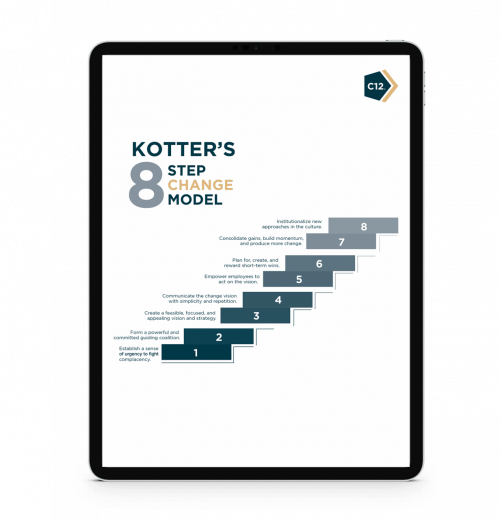8 Steps to Introduce Change Without Wreaking Havoc
Mechanisms for Changing Organizational Culture
The Importance of Change Management
Given the ever-evolving business environment, it is essential for leaders to understand the mechanisms for changing organizational culture. Change can be beneficial for a company by improving current processes, aligning organizational goals, and furthering the mission. However, change can also cause stakeholders to feel threatened and fearful.
Without clear communication, feelings of uncertainty can lead to anger, confusion, and fear among employees, which can hinder the success of even the best-planned strategies. It is important to address these insecurities, even when they are unconscious, to ensure the smooth implementation of change.
As business leaders, we have the opportunity to approach change deliberately and lead employees through it effectively. By understanding how people overcome immunity to change, we can plan our communication and execution strategies to mitigate fear-based frustration and lead our teams to follow us confidently into a new reality.
Overcoming Resistance to Change
“Change is the only constant.” You have likely heard this saying—and felt the weight of its truth intimately—but did you know its origin dates back to over 2,500 years ago? Despite the time that has passed, the truth of this statement remains unchanged, and as a result, business leaders can use its wisdom to navigate the one constant in life: change.
Providing information alone is not always enough to overcome resistance to change. Instead, we must consider how to inspire our teams to feel something. For example, to improve customer service, we can present our employees with the perspective of an underserved customer to evoke empathy. To encourage product development innovation, we can expose them to market competition to create a sense of urgency for change. Focusing on emotions and creating a sense of necessity are two of the greatest mechanisms for changing organizational culture.
Dr. John Kotter’s Sequence for Change
“Managers are trained to make incremental, programmatic improvements. They aren’t trained to lead large-scale change.” – Dr. John Kotter
Leaders often think that change in an organization happens in the following sequence:

Yet how often have we seen this scenario play out successfully? When we see others resist change or not implement it effectively, we might be quick to blame them or some other external factor. Perhaps it has less to do with their propensity and more to do with ours. The root cause of unsuccessful organizational change is often poor change management by the leaders.
We can all think of a change that we have committed to making in some area of our lives that quickly proved the sequence above to be too simplistic and unrealistic. Recognizing that change rarely occurs in this way, Dr. John Kotter, Harvard professor and expert in organizational change, outlines a different sequence that is more likely to effect change:

So how do leaders apply this understanding of influencing behavior change in order to implement change in an organization? In his article “Leading Change: Why Transformation Efforts Fail,” Kotter offers an eight-step process for transforming a company’s organizational culture:

Once we have identified a critical change that our business needs to make, we can use the 8-Step Change Model Worksheet to develop an effective change management plan based on Dr. John Kotter’s model.
When we implement Kotter’s 8-Step Change Model as a whole, without overlooking certain steps, we are more likely to build trust with our team, reduce resistance, and cultivate our biblical values of compassion and unity.
How Company Culture Shapes Employee Motivation
When Trevor Smith, C12 member and president of Maupin Travel, acquired a travel company, he saw that significant changes, such as relocating the business, were needed for the organization to thrive. But he recognized that implementing a new vision in an established business would be difficult for his team members to embrace. Guided by compassion, Trevor used the SEE-FEEL-CHANGE model to cast a compelling vision to the team. Watch this video to hear how Trevor transformed Maupin Travel by faithfully leading his team through change.
Through a series of obstacles and opportunities, Trevor learned that clear communication and corporate values are key mechanisms for changing organizational culture. As we reflect on Trevor’s story, we can see the importance of not just sharing information with our teams, but inspiring them to feel something—that is how meaningful change takes place.
Change for Good
Change is an inherent part of business. It can bring about benefits, such as improved processes and alignment, but it can also cause uncertainty and fear among stakeholders. As leaders, it is our responsibility to clearly communicate the issues, helping our stakeholders understand and feel hope for what could be.
By drawing inspiration from the SEE-FEEL-CHANGE sequence, we can empower our teams to see and feel the change in order to motivate them to take action. Once we have established a common understanding and desire for change, we can use Dr. John Kotter’s 8-Step Change Model to identify opportunities for growth and implement the changes effectively.
Instead of an organization that is frustrated by ineffective ways of doing things, we can help our people grow comfortable with change because it is allowing us to create companies where processes are working and people are flourishing.
At C12, we provide Christian business leaders, CEOs, and business owners with the business tools, peer advisory groups, and executive coaching they need to thrive in business and life. To learn more about C12’s approach to Christ-centered business leadership, find a C12 Business Forum near you.
February 20, 2023






